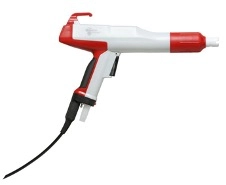Content Menu
● Understanding Electrostatic Spray Technology
>> What is Electrostatic Spray?
>> The Role of Manual Electrostatic Spray Guns
● Advantages of Manual Electrostatic Spray Guns
>> Flexibility and Control
>> Precision in Application
>> Cost-Effectiveness
>> Reduced Downtime
● Integration of Manual Guns in Automated Systems
>> Complementing Automation
>> Training and Skill Development
● Challenges and Considerations
>> Operator Fatigue
>> Consistency in Quality
● Future Trends in Coating Technology
>> Advancements in Manual Spray Guns
>> Sustainability Considerations
● Conclusion
>> Frequently Asked Questions
In the world of industrial coating, the evolution of technology has led to the development of automated systems that promise efficiency, consistency, and high-quality finishes. However, despite the advancements in automation, manual electrostatic spray guns continue to play a crucial role in coating lines. This article explores the reasons behind the enduring relevance of manual electrostatic spray guns, their advantages, and their integration into modern automated systems.

Understanding Electrostatic Spray Technology
What is Electrostatic Spray?
Electrostatic spray technology involves charging paint particles as they exit the spray gun, which then are attracted to the grounded surface of the object being coated. This process enhances the transfer efficiency of the paint, reducing overspray and waste. The charged particles adhere better to the surface, resulting in a more uniform coating.
The Role of Manual Electrostatic Spray Guns
Manual electrostatic spray guns allow operators to have direct control over the application process. This flexibility is particularly beneficial in situations where precision and adaptability are required. While automated systems can handle large volumes and repetitive tasks, manual guns provide the human touch necessary for complex or variable applications.
Advantages of Manual Electrostatic Spray Guns
Flexibility and Control
One of the primary advantages of manual electrostatic spray guns is the flexibility they offer. Operators can adjust the spray pattern, flow rate, and pressure according to the specific requirements of the job. This adaptability is essential when dealing with different substrates, shapes, and sizes of objects.
Precision in Application
Manual spray guns allow for precise application, especially in intricate areas where automated systems may struggle. For example, when coating complex geometries or detailed designs, the operator can maneuver the gun to ensure complete coverage without overspray. This precision is vital in industries such as automotive, aerospace, and furniture manufacturing, where quality standards are high.
Cost-Effectiveness
While automated systems can be expensive to install and maintain, manual electrostatic spray guns are generally more cost-effective. They require less initial investment and can be easily integrated into existing production lines. For smaller operations or those with varying production needs, manual guns can provide a more economical solution without sacrificing quality.
Reduced Downtime
In automated systems, any malfunction can lead to significant downtime, affecting overall productivity. Manual electrostatic spray guns, on the other hand, can be quickly repaired or replaced, minimizing disruptions. Operators can also switch between different colors or materials more easily, allowing for faster changeovers and increased efficiency.
Integration of Manual Guns in Automated Systems
Complementing Automation
Rather than replacing manual electrostatic spray guns, many automated coating lines incorporate them as complementary tools. This hybrid approach allows manufacturers to leverage the strengths of both manual and automated systems. For instance, manual guns can be used for touch-ups, repairs, or in areas that require detailed work, while automated systems handle the bulk of the coating process.
Training and Skill Development
The use of manual electrostatic spray guns also emphasizes the importance of skilled labor in the coating industry. Operators must be trained to understand the nuances of electrostatic spray technology, including how to adjust settings for different materials and conditions. This skill development is crucial for maintaining high-quality standards and ensuring that operators can effectively troubleshoot issues as they arise.
Challenges and Considerations
Operator Fatigue
One of the challenges associated with manual spray guns is operator fatigue. Continuous use can lead to physical strain, which may affect the quality of the application. To mitigate this, manufacturers can implement ergonomic designs for spray guns and provide regular breaks for operators.
Consistency in Quality
While manual guns offer precision, maintaining consistency across multiple operators can be challenging. Variations in technique can lead to differences in coating thickness and finish. To address this, companies can establish standard operating procedures and conduct regular training sessions to ensure all operators are aligned in their application methods.
Future Trends in Coating Technology
Advancements in Manual Spray Guns
As technology continues to evolve, so do manual electrostatic spray guns. Innovations such as improved ergonomics, lighter materials, and enhanced control systems are making these tools even more effective. Additionally, the integration of smart technology allows for real-time monitoring and adjustments, further enhancing the capabilities of manual spray guns.
Sustainability Considerations
With increasing emphasis on sustainability, the coating industry is also focusing on reducing waste and improving environmental impact. Manual electrostatic spray guns contribute to this goal by minimizing overspray and ensuring efficient use of materials. As manufacturers seek to adopt greener practices, the role of manual guns in achieving these objectives will likely grow.
Conclusion
In conclusion, manual electrostatic spray guns remain an essential component of automated coating lines due to their flexibility, precision, cost-effectiveness, and ability to complement automated systems. As the industry continues to evolve, the integration of manual guns with advanced technologies will ensure that they remain relevant in the face of increasing automation. The human element they provide is irreplaceable, making them a vital tool for achieving high-quality finishes in various applications.

Frequently Asked Questions
1. What are the main benefits of using manual electrostatic spray guns?
- Manual electrostatic spray guns offer flexibility, precision, cost-effectiveness, and reduced downtime, making them ideal for various applications.
2. How do manual spray guns complement automated coating systems?
- They are used for touch-ups, repairs, and detailed work, allowing manufacturers to leverage the strengths of both manual and automated systems.
3. What challenges do operators face when using manual spray guns?
- Operator fatigue and maintaining consistency in quality across different users are common challenges.
4. What advancements are being made in manual spray gun technology?
- Innovations include improved ergonomics, lighter materials, and smart technology for real-time monitoring and adjustments.
5. How do manual electrostatic spray guns contribute to sustainability?
- They minimize overspray and ensure efficient use of materials, helping manufacturers reduce waste and improve their environmental impact.
Hot Tags: China, Global, OEM, private label, manufacturers, factory, suppliers, manufacturing company










































 .
. 